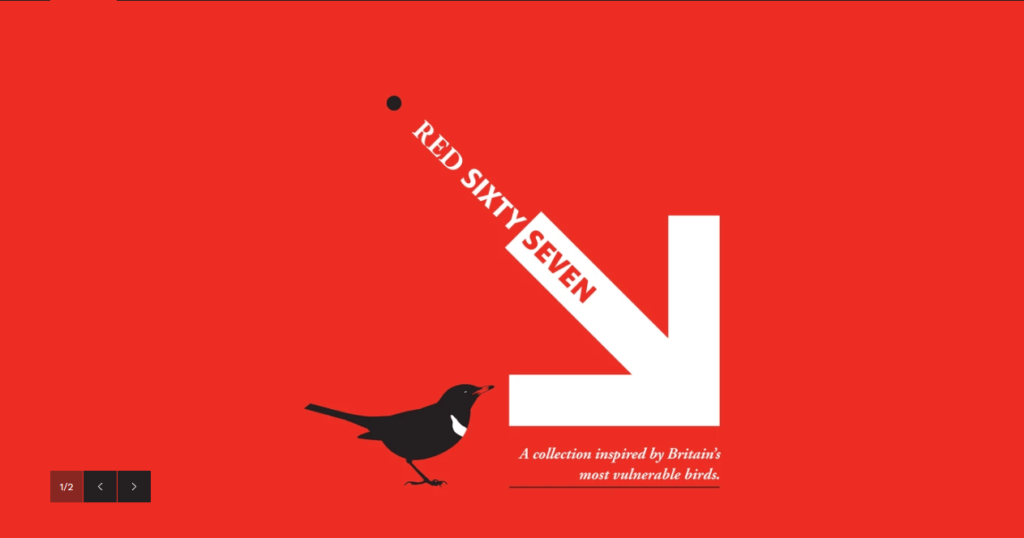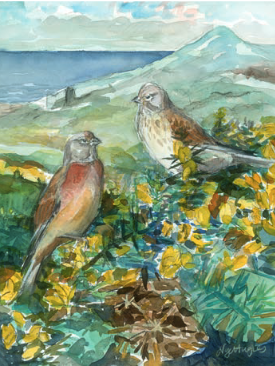
This book, 67 species, 67 authors, 67 artists, is about the red-listed birds of the UK and goes on sale on Valentine’s Day. Show some love for our birds and buy a copy, please. Money from sale will go to RSPB and BTO projects on the Red67.

All the artwork is brilliant and I expect 66 of the species accounts are paeans for the species concerned. But I wrote the Linnet account and it’s difficult to be gushingly enthusiastic for such a species.
Still, the Linnet is in trouble so I guess it needs our help.
And you can help the dreary Linnet and 66 other species by buying this book – click here.
[registration_form]
I love the linnet. I would like to know what it is that is so upsetting about them, however, I’m afraid to ask as it may turn into another DDD. (Daft daffodil debate).
Already got my order in for the book though.
I totally agree, Paul. All birds are interesting, beautiful and amazing creatures. I love their delicate feathers, their beautiful eggs, their flights and their songs.
Why do we have to criticise our fellow creatures? They’re all part of this intricate and fragile web of life.
Three dislikes?? What have people misread here?
Don’t dilly or dally ,Carry on with your old cock linnet!
Hmm – I wonder if your professed negative feelings towards the linnet are a bit like in one of those cheesy rom-coms where the protagonists’ initial antipathy to one another is eventually overcome and it turns out that they are actually madly attracted to each other and it all finishes in a happy ending where they fall into each others arms?
In any case I hope the book sells well and raises plenty of money for a good cause!
‘We have, in winter, vast flocks of the common linnets … These, when spring advances assemble in the sunshine, and join in a gentle sort of chirping …’ [Gilbert White writing to Thomas Pennant, 22nd Jan. 1768]
Perversely, Linnets can become more interesting by being less common, but that does nothing for the dreariness already permeating landscapes and soundscapes as their crowds dwindle and their choruses fade.
Linnets to me are the bird of informal, rough corners – exactly the sorts of places that are ripe for development or well intentioned tree planting. And like a number of other red 67 birds, a species that once went automatically onto every list has now become something you have to search for.
When as a budding birder as a child back in the late fifties and early sixties I did much of my birdy learning trespassing on the local golf course. There was one or two areas that always had Linnets, Bullfinches and sometimes Lesser Redpolls the little gorse and hawthorn islands in the roughs. In them I eventually found the nests of all three, Linnet nests proved to be the hardest to find yet it was, by far, the commonest of these three finches.
As an adult one of the birds I radio tracked looking at pesticide risk was Linnet the hardest of all the small birds we tried to follow to keep track of using a just 0.5g tag.
So the humble linnet is something I have long been familiar with despite its ever increasing decline but then those scrubby field corners Roderick refers to where they nested and found ample weed seeds are largely no more. Linnet is not near the top of my list of much loved birds but its not near the bottom either, Mark!
Our birding lives and indeed our environment would be far better if all of these 67 species were much commoner and certainly not declining.
Why would I buy this book when the Common Swift is probably not even listed? BoCC has it amber-listed.
The recent BB paper on Population estimates of birds in GB says there are 560,000 Linnets in the UK, The latest BBS index is about 80%.
There are over 5 million pairs of House Sparrows in the country with a fairly stable population (2018 BBS index about 98%). There are 1.7 million pairs of Starlings in the country with a stable population for the last 10 years (2018 BBS about 45%)
At the same time they have Swift at 59,000 pairs declining at over 5% per annum since 1994 (2018 index less than 40%).
The September 2017 BB has a paper on the Risk of Extinction of Birds in GB based on the much more sensible IUCN system. Swift is classed as “Endangered”, Linnet is classed as “Near threatened”, and House Sparrow and Starling are of “least concern”.
How can this make any sense? – when will BoCC wake up from their sloth and pull their finger out?
The damage that their dysfunctional process can do is exemplified by a recent planning application here, based on the ridiculous BoCC system, where the ecologist has specified:
38 Sparrow terraces (that’s 114 nest chambers!) – with 5 million pairs of House Sparrows in the country, population stable
29 Starling boxes – with 1.7 million pairs of Starlings – population stable for the last 10 years
24 Swift boxes – 59,000 pairs of swifts declining at over 5% per annum
47 bat boxes (each one holding 10’s of bats) – there are 6 million bats in churches alone in the country!
Has no one told them Sparrow Terraces are useless? Both House and Tree Sparrows prefer Swift boxes. Occupancy rates of Sparrow Terraces is very low – you may get a few tits using them.
For cavity nesting small birds, Swift boxes are the nearest there is to a general purpose bird box.
In one of our projects with 71 Swift boxes on some council flats, when last checked it had 12 pairs of Swifts, 45 pairs of House Sparrows, a few Great Tits as well as a couple with Tree Bumblebees.
It makes me angry.
But I do like Linnets.
Good occupancy rates in our sparrow terrace over the years. Bees, mice, wasps and blue tits etc. Meanwhile, the sparrows use last years House Martin nests and wreck them. Gotta luv em though.
Hi Mark, I can somewhat see your point of view about male linnets being a bit gaudy, but that’s only if you have the chance to see them close up. In my experience, most of the time, it’s just the song, call or flash of the black and white of the tail among some goursey habitat that typifies the usual encounter! Indeed, when desperately trying to get good field studies for my painting above (with a increasing sense of panic on the looming deadline) I appreciated quite how restless linnets can be. Anyway, it was great to be a part of raising awareness of the vulnerability of these little birds, and glad your writing (if a little controversial on the merits of the male linnet!) is promoting good discussion. Sincerely, Nye
Nye – very many thanks! You made t5he Linnet look as good as it is possible to do!
I once hard the Linnet described as: ‘a poor mans Twite’, which I felt was a tad harsh.
The farmland around my village isn’t hospitable for them any more which is great shame, but they do very well on a nearby heathland golf course where they frequent the abundant gorse and the mature and degenerate heather.
Whenever I see a Linnet, I instantly associate it with the ‘coconutty’ aroma of European gorse.